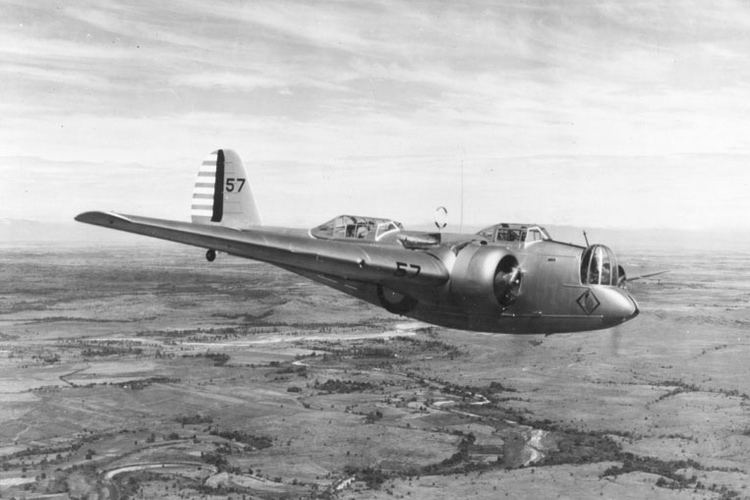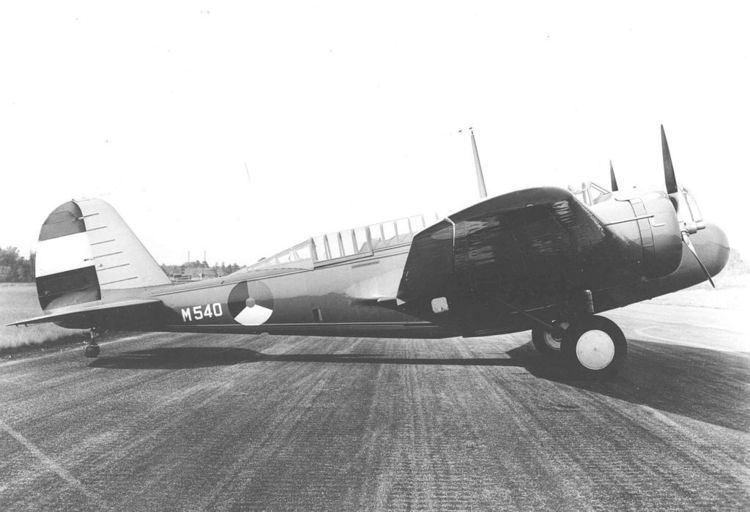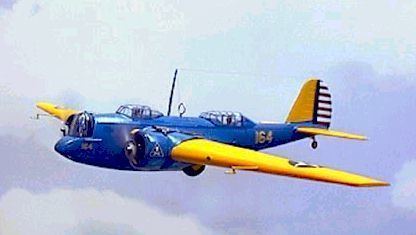Top speed 343 km/h Wingspan 22 m Weight 4,391 kg Engine type Wright R-1820 Cyclone | Range 2,205 km Length 14 m Unit cost 52,083–52,083 USD | |
 | ||
Martin b 10 b 12a
The Martin B-10 was the first all-metal monoplane bomber to be regularly used by the United States Army Air Corps, entering service in June 1934. It was also the first mass-produced bomber whose performance was superior to that of the Army's pursuit aircraft of the time.
Contents
- Martin b 10 b 12a
- Martin b 10 bomber at air force museum
- Design and development
- Operational history
- Legacy
- Martin Model 123
- Martin Model 139 139A and 139B
- Model 139W and 166
- Operators
- Survivors
- Specifications B 10B
- References

The B-10 served as the airframe for the B-12, B-13, B-14, A-15 and O-45 designations using Pratt & Whitney engines instead of Wright Cyclones. A total of 348 of all versions were built. Biggest users were the USA, with 166, and the Netherlands, with 121.

Martin b 10 bomber at air force museum
Design and development

The B-10 began a revolution in bomber design. Its all-metal monoplane airframe, along with its features of closed cockpits, rotating gun turrets (almost simultaneously to the British Overstrand biplane bomber's own enclosed nose-turret), retractable landing gear, internal bomb bay, and full engine cowlings, would become the standard for bomber designs worldwide for decades. It made all existing bombers completely obsolete. In 1932, Martin received the Collier Trophy for designing the XB-10.

The B-10 began as the Martin Model 123, a private venture by the Glenn L. Martin Company of Baltimore, Maryland. It had a crew of four: pilot, copilot, nose gunner and fuselage gunner. As in previous bombers, the four crew compartments were open, but it had a number of design innovations as well.
These innovations included a deep belly for an internal bomb bay and retractable main landing gear. Its 600 hp (447 kW) Wright SR-1820-E Cyclone engines provided sufficient power. The Model 123 first flew on 16 February 1932 and was delivered for testing to the U.S. Army on 20 March as the XB-907. After testing it was sent back to Martin for redesigning and was rebuilt as the XB-10.
The XB-10 delivered to the Army had major differences from the original aircraft. Where the Model 123 had Townend rings, the XB-10 had full NACA cowlings to decrease drag. It also sported a pair of 675 hp (503 kW) Wright R-1820-19 engines, and an 8 feet (2.4 m) increase in the wingspan, along with an enclosed nose turret. When the XB-10 flew during trials in June, it recorded a speed of 197 mph (317 km/h) at 6,000 ft (1,830 m). This was an impressive performance for 1932.
Following the success of the XB-10, a number of changes were made, including reduction to a three-man crew, addition of canopies for all crew positions, and an upgrade to 675 hp (503 kW) engines. The Army ordered 48 of these on 17 January 1933. The first 14 aircraft were designated YB-10 and delivered to Wright Field, starting in November 1933, and used in the Army Air Corps Mail Operation. The production model of the XB-10, the YB-10 was very similar to its prototype.
Operational history
In 1935, the Army ordered an additional 103 aircraft designated B-10B. These had only minor changes from the YB-10. Shipments began in July 1935. B-10Bs served with the 2d Bomb Group at Langley Field, the 9th Bomb Group at Mitchel Field, the 19th Bomb Group at March Field, the 6th Composite Group in the Panama Canal Zone, and the 4th Composite Group in the Philippines. In addition to conventional duties in the bomber role, some modified YB-10s and B-12As were operated for a time on large twin floats for coastal patrol.
With an advanced performance, the Martin company fully expected that export orders for the B-10 would come flooding in. The Army owned the rights to the Model 139 design. Once the Army's orders had been filled in 1936, Martin received permission to export Model 139s, and delivered versions to several air forces. For example, six Model 139Ws were sold to Siam in April 1937, powered by Wright R-1820-G3 Cyclone engines; 20 Model 139Ws were sold to Turkey in September 1937, powered by R-1820-G2 engines.
On 19 May 1938, during the Sino-Japanese War, two Chinese Nationalist Air Force B-10s successfully flew to Japan. However, rather than dropping bombs, the aircraft dropped propaganda leaflets. That followed the project submitted during February 1938. Two French pilots from the 14th International Volunteer Squadron prepared a raid for dropping incendiary bombs over Kagoshima. It was refused.
The Dutch Martins fought in the defense of Singapore and the Netherlands East Indies.
Legacy
At the time of its creation, the B-10B was so advanced that General Henry H. Arnold described it as the airpower wonder of its day. It was half again as fast as any biplane bomber, and faster than any contemporary fighter. The B-10 began a revolution in bomber design; it made all existing bombers completely obsolete.
Rapid advances in bomber design in the late 1930s meant that the B-10 was eclipsed by the time the United States entered World War II. The 139s in combat in China and South East Asia suffered the same disadvantages as the other early war medium bombers, i.e. not enough armour and guns, while it couldn't outrun the latest fighters. Nevertheless, the 166 had the highest performance of all the medium bombers in the theatre at the time, early 1942.
An abortive effort to modernize the design, the Martin Model 146, was entered into a USAAC long-distance bomber design competition 1934–1935, but lost out to the Douglas B-18 and much bigger Boeing B-17. The B-18 was hardly superior to the B-10 and actually inferior to the latest B-10 version, the model 166.
Martin Model 123
Private venture of Martin company, predecessor of the XB-10, served as prototype for the series, one built.
Martin Model 139, 139A and 139B
Army Air Corps versions, 165 built.
Model 139W and 166
The export versions, 100 built (182 including the Model 166, see below).
Final version, a.k.a. 139WH-3 and 139WH-3A, 82 built.
Export version for the Netherlands, used in the Netherlands East Indies. Redesigned wings, nose and single 'glass house' canopy, bomb shackles between engines and fuselage, and better engines. The WH-3 had two 900 hp (671 kW) R-1820-G5 (40 built, delivered September 1938), the WH-3A had two 1,000 hp (671 kW) R-1820-G-105A (42 built, delivered March 1940). With the bomb shackles the bomb load could be doubled for a shorter range. A total of 121 of all types were built for the Dutch.Operators
Survivors
Specifications (B-10B)
Data from United States Military Aircraft Since 1909
General characteristics
Performance
Armament
